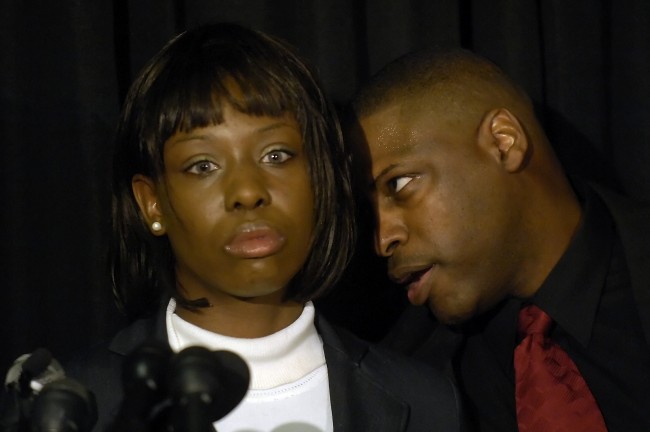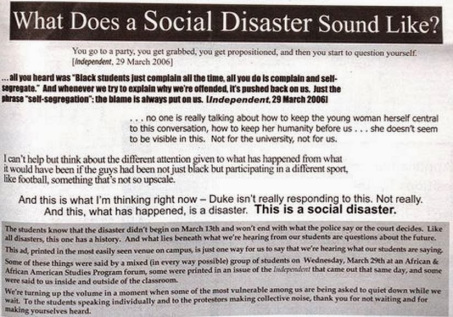The Duke lacrosse rape accuser is back in court: blame white males with money

The Duke lacrosse rape accuser returns to court:
“The Associated Press reports that Crystal Mangum, whose accusations of gang rape against Duke University lacrosse players were revealed to be fake, has appealed her conviction in the stabbing death of her boyfriend: Attorney Ann Petersen asks that Mangum get a new trial. Petersen says the jury shouldn’t have been allowed to hear evidence about an attack on another man in February 2010.”
Back when Magnum made her claims, the media embarked on a feeding frenzy.
Travel back to 2006. Syracuse University early on got into the act when it decided not to accept as transfers any students from the Duke lacrosse team—not just the three accused chaps, mind you, but anyone contaminated by having played lacrosse for Duke. “I think it would be inappropriate,” sniffed Syracuse athletic director Daryl Gross. (Where is he now? Llama farming in Peru? Nope. Still athletic director at Syracuse.)
But there are at least two other aspects of the case that deserve comment. One is the role of the media, which pounced on the story with unseemly delight. Oh, how The New York Times, The Boston Globe, and countless other bastions of liberal self-satisfaction loved it! Race. Class. Sex. Victimhood. It was the perfect morality tale. Those white jocks at “the Harvard of the South” just had to be guilty. And what a good time we were all going to have lacerating the malefactors while at the same time preening ourselves on our own superior virtue!
The editorials, the op-eds, the comments, the analyses poured forth non-stop, demonstrating that one of the deepest human passions is the urge to self-righteous pontification. The novelist Allan Gurganus epitomized the tone in an op-ed for the Times in April 2006: “The children of privilege,” he thundered, “feel vividly alive only while victimizing, even torturing.” You don’t say? Even sports writers got into the act. Selena Roberts located Duke University “at the intersection of entitlement and enablement, . . . virtuous on the outside, debauched on the inside.” By August 2006, as District Attorney Michael Nifong’s case was betraying worrisome fissures, the Times published a 6,000-word article arguing—“praying” might be a more apposite term—that, whatever weaknesses there might be in the prosecution’s case, “there is also a body of evidence to support [taking] the matter to a jury.” As the Times columnist David Brooks ruefully noted after the tide had begun to turn, the campaign against the athletes had the lineaments of a “witch hunt.”
Indeed. Richard Brodhead, Duke’s president, got out his broomstick and suspended the accused students, fired the lacrosse coach, cancelled the rest of the team’s season, and pandered to every possible PC interest, but especially to those baying for the heads of the accused. (One commentator estimated that only 3 percent of Brodhead’s statements could be construed as supporting the accused students.)
And then there was the Duke faculty. As Vincent Carroll, writing in the Rocky Mountain News, noted, “the most astonishing fact, hands down, was and remains the squalid behavior of the community of scholars at Duke itself. For months nearly the entire faculty fell into one of two camps: those who demanded the verdict first and the trial later, and those whose silence enabled their vigilante colleagues to set the tone.”

Particularly egregious was the behavior of the “Group of 88,” a congeries of faculty activists and fellow-travelers who signed “What Does a Social Disaster Sound Like?,” a full-page manifesto published in April 2006 in the Duke student newspaper. The statement, which purported to be “listening” to students on campus, mingled anonymous student comments with racialist agitprop. “Regardless of the results of the police investigation,” ran part of the introductory comment, “what is apparent every day now is the anger and fear of many students who know themselves to be objects of racism and sexism.” There followed a mosaic of histrionic proclamations: “We want the absence of terror,” one student is supposed to have said. “But we don’t really know what that means.” “This is not a different experience for us here at Duke University. We go to class with racist classmates, we go to gym with people who are racists . . .”
Sounds like an agenda:
Michael W. Chapman at CNS News:
When Crystal Mangum falsely accused several Duke lacrosse players of rape in 2006, there were 160 major television news stories in the first five days after the players were arrested, but in 2013, when Mangum was convicted of murder and sentenced to 14 years in prison, there were only 3 major television news stories, a difference in coverage of 5,233%.
The knowing knew. Amanda Marcotte knew:
“I’ve been sort of casually listening to CNN
blaring throughout the waiting area and
good f–king god is that channel pure evil.
For awhile, I had to listen to how the
poor dear lacrosse players at Duke are being
persecuted just because they held someone down
and f–ked her against her will — not rape,
of course, because the charges have been
thrown out. Can’t a few white boys
sexually assault a black woman anymore without
people getting all wound up about it? So unfair.”
You can read Marcotte’s bon mots at the Guardian.
English Professor Houston Baker publicly condemned the University’s “moral response to abhorrent sexual assault, verbal racial violence, and drunken white male privilege loosed amongst us.” In a letter to University Provost Peter Lange, he wrote:
The lacrosse team – 15 of whom have faced misdemeanor charges for drunken misbehavior in the past three years – may well feel they can claim innocence and sport their disgraced jerseys on campus, safe under the cover of silent whiteness. But where is the black woman who their violence and raucous witness injured for life? Will she ever sleep well again?
It’s a journalistic travesty that Rolling Stone’s discredited and disgraceful University of Virginia rape story ever made it into print.
What’s more shameful is how so many people actually hoped the gory – and phony – tale of the fraternity gang-rape was true.
It’s as if many activists and politicians wanted a freshman named Jackie to have been brutally assaulted in September 2012 by seven men at the Phi Kappa Psi frat house. It’s as if they hoped she had gone through a three-hour ordeal that ended in her fleeing the house party in a blood-stained dress.
Because as horrific as all that would have been, it would have helped their agenda.
Photo: Crystal Mangum, the alleged victim in the Duke lacrosse rape case, addresses the media during a press conference on the release of Mangum’s forthcoming book “The Last Dance for Grace: The Crystal Mangum Story,” while her publisher and co-author Vincent Clark advises her in Durham, N.C., on Thursday, Oct. 23, 2008. The woman who North Carolina prosecutors determined falsely accused three Duke lacrosse players of raping her at a team party maintains in her new memoir that she was attacked. (AP Photo/Sara D. Davis)
Posted: 3rd, January 2015 | In: Reviews 0 Comments | TrackBack | Permalink


